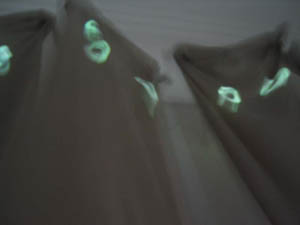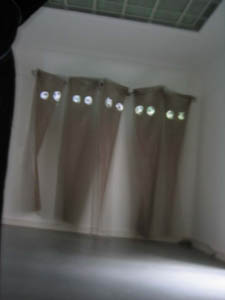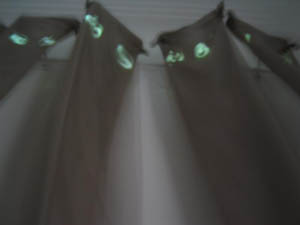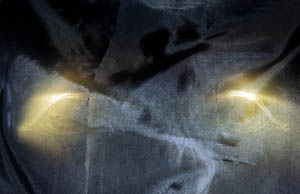Ghosts
2004
installation/object/video/audio
Sorry, this text is now available in Russian only
Каждую пятницу в семь часов вечера с площади перед мэрией Москвы отправляется автобусная экскурсия. Ее тема - "Таинственные и загадочные места Москвы". Людям рассказывают о красном пятне на стене Кремля, о мятущихся духах Замоскворечья и черной руке на Новодевичьем кладбище...
Москва, как любой старый город, полна не только мифов, но и настоящих загадочных физических явлений. Мне хотелось бы обозначить существование сверхъестественного в стерильных современных выставочных залах. Это не призраки, приехавшие в гости. Я - охотник за привидениями. Привидения проявят гения места.
Контексты людей не совпадают с контекстами духов. Духи и привидения пребывают в литературе. Мне хотелось бы "перевести" их в науку или особые спиритические технологии. Неизбежно возникает вопрос о медиуме. Думаю, любой художник, обладающий опытом, может быть проводником спиритических технологий. При этом я понимаю, что ничего нельзя исследовать или расследовать: когда на Венецианской биеннале латышская журналистка спросила, не спекулирую ли я на "теме Бога", я ответил, что, наоборот, - Бог всегда спекулирует нами (и мной), и в этом смысле ее предположение - большой комплимент. У художников врагов нет, просто что-то не нравится. Например, меня печалят превратные представления о "грязной" и "дикой" России, "прекрасной" Европе и "свободной" Америке. Художник не отдыхает, но предпочитает комфортные условия для работы.
(Сергей Шутов)This project was represented at
HA KYPOPT! RUSSIAN ART TODAY exhibition
at the State Kunsthalle Baden-Baden (May 1 - June 27, 2004) and
at the State Exhibition Hall "Novy Manege", Moscow (July 21 - August 8, 2004)(press-release)
Who are the key representatives of contemporary art in Russia today? The considerable surge of western interest in Russian art in the wake of perestroika was followed by a phase of merely average exchange. But what happened after Gorbachev and Kabakov? In response to this question, and as material for further debate, the Staatliche Kunsthalle Baden-Baden is putting on an exhibition of contemporary Russian entitled "HA KYPOPT" (Off to the Spa) which includes installations, photographs, videos and performances by 35 artists representing various aspects of the Russian art scene in Moscow and Berlin over the past ten years.
Russia and Baden-Baden have a special relationship. The German word "Kurort" (spa) is a loan word in Russian (as in the title of our exhibition "KYPOPT"). What is more, the terms KYPOPT (spa) and Baden-Baden are almost synonymous in Russian – expressing an affectionate view of the spa-city on the river Oos as seen from the depths of the still huge Russia! Fyodor Dostoyevsky, a famous visitor to Baden-Baden and its casino, enlivened his grotesque and partly tragic novel The Gambler with humorous observations on "Roulettenburg" (= Baden-Baden). For the opening of the exhibition, Dostoyevsky will be coming back here again in the shape of his artistic revenant, Vladislav Mamychev-Monroe.
Travelling to Russia today, one encounters a lively art scene where performance meets social criticism, and the farcical-aggressive meets a gentle poetry informed by literature and philosophy. One also senses a tangibly anarchistic insistence on the freedom of art. People are intellectually restive, highly concentrated, attentive, forceful – the very opposite of paralysed!
A characteristic feature of this generation of young artists is their direct engagement with social reality. Unlike the intellectual Conceptualism of 1980s Moscow, the 1990s generation seeks to engage in direct dialogue with the social and the commonplace. The photographs by artists such as Boris Mikhailov and Georgij Pervov show the upheavals and social hardships brought about by social change in Russia. Other artists intervene directly in social structures, as social sculptors. Thus in the Russian village of Nikola-Lenivez, Nikolaj Polisski organised collective actions involving the whole community. Vladimir Archipov also seeks to enter into dialogue with the non-art of the everyday. For his project Functioning Sculpture from Baden, carried out specially for Baden-Baden, he tracked down commonplace inventions and home-made items in and around Baden-Baden, presenting these utility goods as documents of applied everyday creativity. The Moscow artist group "Radek" sees itself as representative of a left-wing social activism. Its members are trying to salvage the value of collective creative processes – in a society increasingly more focussed on individualisation and consumerism – by means of joint projects and political demonstrations.
Body and Performance Art
A recurrent metaphor in contemporary Russian art is that of the body as the site of direct engagement with physical reality. Artists like Irina Korina or "The Blue Noses" examine the socially-formed body. For Oleg Kulik, the human body is an important – if not the only remaining – point of departure for individual self-ascertainment. This internationally renowned artist is represented in the exhibition by his erotically charged "Lolita" depictions, which stand for an attempt to win back the body as the site of individuality, that same body which Communism tended to expropriate as a socialist body. The human body is also an important expressive tool in the field of performance art and is given a lot of scope at the beginning of the exhibition (La Rose Sauvage, Natalia Mali / Andrei Prigov, Marina G. M. Ljubaskina-S., Vladislav Mamychev-Monroe, Nina and Torsten Romer, Leonid Sochranski). Within the framework of this exhibition, Elena Kovylina, who represents a type of radical performance bordering on auto-aggression, will carry out a tee ceremony which will burst into flames all around her. The performance artist Vladislav Mamychev-Monroe, by contrast, uses his body as a projection screen. He regularly "performs" as contemporary and historical personalities such as Hitler, Bin Laden or Lenin. In Baden-Baden he alludes to the city's German-Russian past by embodying the figure of Dostoyevsky. The return of Dostoyevsky as The Gambler for the exhibition opening will be documented for its duration by means of photographs.
Like Vladislav Mamychev-Monroe, many contemporary Russian artists in a post-Soviet country marked by upheaval use art for the purposes of self-determination. Following on their enthusiasm about the first blossoming of perestroika, people have become more sober. In view of the fact that, so far, many artistic hopes for a dialogue between society, politics and the media have been frustrated, and that some artists (mockingly called Neo-Liberals in Moscow) are orientating themselves more towards the art market, artist personalities like Oleg Kulik are already demanding that their colleagues turn their minds to the studio again (cf. his video The Coordinate System). For them, this does not involve a retreat. Instead, as a result of such a concentration on the studio, art should subsequently emerge more clearly as a critical corrective and a cultural counterforce.
Catalogue: Matthias Winzen / Georgij Nikitch (eds.), with texts by, among others, Oleg Aronson, Jekaterina Degot, Nicole Fritz, Jorg Katerndahl, Viktor Misiano, Nina and Torsten Romer, Olesja Turkina, and an illustrated 1991-2003 chronicle by Ekaterina Lazareva and Georgij Nikitch, as well as contributions by the artists. Wienand Verlag, Cologne, pp. c. 200, 100 colour and 30 black-and-white illustrations. Ђ 27
The project is being subsidised by the Kulturstiftung des Bundes and by the Ministry of Science, Research and Art of the State of Baden-Wurttemberg.



